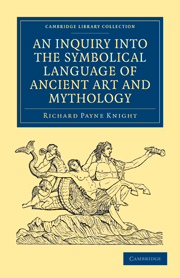
-
Select format
-
- Publisher:
- Cambridge University Press
- Publication date:
- February 2012
- May 2011
- ISBN:
- 9780511920394
- 9781108028103
- Dimensions:
- Weight & Pages:
- Dimensions:
- (216 x 140 mm)
- Weight & Pages:
- 0.27kg, 210 Pages
You may already have access via personal or institutional login- Subjects:
- Classical Studies, History of Ideas, Classical Studies (General), Social and Cultural Anthropology, Anthropology, General
Book description
This influential work of 1818 by dilettante and critic Richard Payne Knight (1751–1824) has stood the test of time. The study investigates the sexual symbolism of the art of different religions, providing a key to the mythology of the ancients and fostering a clear understanding of the canons and principles of art. An eminent art historian, collector and textual critic, Knight led the way in convincing British taste that Roman art was inferior to Greek, arguing that Greek art was the more authentic and original. Here, he calls for more correct versions of Homer, Plato and other Hellenic writers, to obtain accurate perceptions of Grecian ideas. Demonstrating his in-depth knowledge of classical architecture and literature, and drawing upon his considerable resources as a collector, Knight analyses the genetic character of symbols, and the patterns of their occurrence in different cultures.
Metrics
Full text views
Full text views help Loading metrics...
Loading metrics...
* Views captured on Cambridge Core between #date#. This data will be updated every 24 hours.
Usage data cannot currently be displayed.
Accessibility standard: Unknown
Why this information is here
This section outlines the accessibility features of this content - including support for screen readers, full keyboard navigation and high-contrast display options. This may not be relevant for you.
Accessibility Information
Accessibility compliance for the PDF of this book is currently unknown and may be updated in the future.

